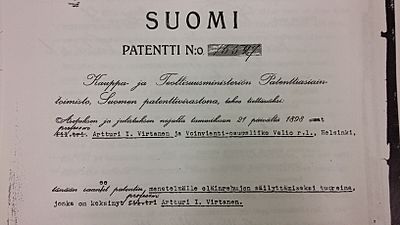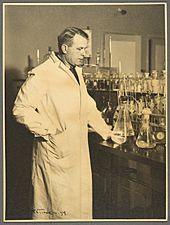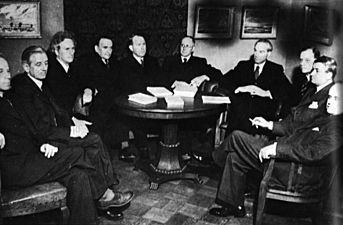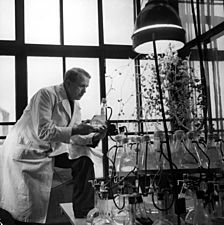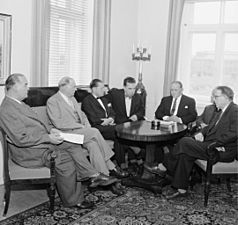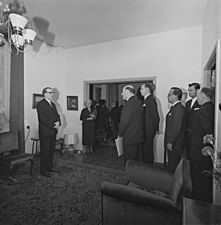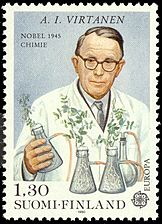Artturi Ilmari Virtanen facts for kids
Quick facts for kids
Artturi Ilmari Virtanen
|
|
|---|---|
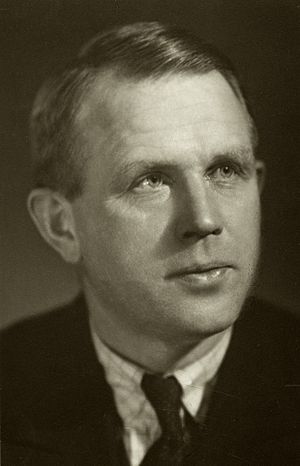
Virtanen in 1945
|
|
| Born |
Artturi Ilmari Virtanen
15 January 1895 |
| Died | 11 November 1973 (aged 78) Helsinki, Finland
|
| Resting place | Hietaniemi Cemetery, Helsinki |
| Nationality | Finnish |
| Alma mater | University of Helsinki |
| Known for | AIV fodder |
| Spouse(s) |
Lilja Moisio
(m. 1920; died 1972) |
| Children | 2 |
| Awards | Nobel Prize in Chemistry (1945) |
| Scientific career | |
| Fields | Chemistry |
| Institutions |
|
Artturi Ilmari Virtanen (born January 15, 1895 – died November 11, 1973) was a Finnish chemist. He won the 1945 Nobel Prize in Chemistry. He received this award for his important work in farming and food chemistry. He was especially known for his method of keeping animal feed fresh.
He created something called AIV silage. This helped farmers produce more milk. He also found a way to keep butter from spoiling, called AIV salt. These inventions helped Finland export more butter.
Contents
About Artturi Virtanen's Life
Artturi Ilmari Virtanen was born in Helsinki, Finland, on January 15, 1895. His father, Kaarlo Virtanen, was a train driver. His mother was Serafina Isotalo.
He finished school at the Classical Lyceum in Viipuri, Finland. In 1920, he married Lilja Moisio, who was a botanist. They had two sons together.
In 1933, he bought a farm near Helsinki. He used this farm to test his scientific ideas in real life. Artturi lived a very simple life. He passed away in November 1973 from pneumonia. He had broken his leg a few weeks before. He was buried in the Hietaniemi Cemetery.
Artturi's Journey in Science
Virtanen started studying chemistry at the University of Helsinki in 1913. He earned his Master's degree and then his PhD in organic chemistry in 1918. In 1919, he began working at the laboratories of Valio. Valio is a big company that makes dairy products. He became the director of their laboratory in 1920.
He felt he needed to learn more, especially about botany (the study of plants) and zoology (the study of animals). So, he left Valio to continue his education. He studied at places like the University of Münster and the University of Stockholm. There, he learned about physical chemistry, soil chemistry, and microbiology. In 1923, he worked with Hans von Euler-Chelpin in Sweden. Hans von Euler-Chelpin later won a Nobel Prize in Chemistry in 1929.
When Virtanen returned to Finland, he became a lecturer at the University of Helsinki in 1924. He was known for his interesting talks about the chemistry of life. He also worked in a laboratory for the Butter Export Association, which later became part of the university. In 1930, the Institute for Biochemistry was created. Virtanen worked there until he died in 1973. He also became a professor of biochemistry at the Helsinki University of Technology in 1931 and at the University of Helsinki in 1939.
Important Discoveries and Work
Virtanen's research began with studying how sugars change in plants in 1924. He showed that a process called phosphorylation is the first step in many important reactions that help living things get energy.
In 1925, he became interested in bacteria that help plants get nitrogen from the air. These bacteria live in the roots of bean plants. He also found better ways to keep butter fresh. He added a special salt called disodium phosphate to stop it from going bad. This method was used in Finland for many years.
His most famous work, from 1925 to 1932, was inventing a way to keep animal feed fresh. This method is called AIV fodder. He received a patent for it in 1932. It was a type of silage that helped store green feed for animals, which was very important during long winters. His method involved adding a small amount of hydrochloric or sulfuric acid to the fresh feed. This increased the acidity, which stopped harmful bacteria from growing. It also kept the feed nutritious and safe for animals. Because of this invention, Virtanen received the Nobel Prize in chemistry in 1945.
In his later years, he worked on creating special feeds for cattle. These feeds allowed cows to use simple substances like urea and ammonium salts to make the amino acids they needed, instead of needing lots of protein from plants like soybean. He also led the Valio Laboratory for many years, from 1921 to 1969.
Awards and Special Recognitions
Winning the Nobel Prize brought Artturi Virtanen many honors. He was invited to join many science groups and received special degrees from universities around the world. He was a member of science academies in Finland, Norway, Sweden, and other countries. He also received honorary degrees from universities like Lund, Paris, and Helsinki.
An asteroid was named after him, called 1449 Virtanen. It was discovered by a famous Finnish astronomer. A crater on the Moon, called Virtanen, was also named in his honor.
Gallery
See also
 In Spanish: Artturi Ilmari Virtanen para niños
In Spanish: Artturi Ilmari Virtanen para niños


